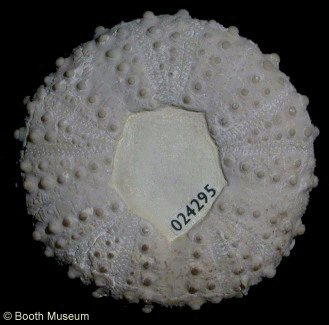 A
A
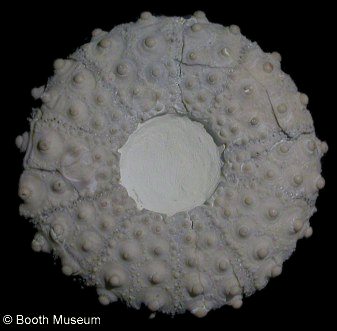 B
B|
Phymosoma koenigii (Mantell, 1822) |
An attractive and moderately common regular echinoid from the Coniacian to Early Campanian of the White Chalk. Though superficially similar to the contemporary Gautheria (e.g. Gautheria spatulifera and Gautheria radiata), the tests of Phymosoma can be distinguished by certain fundamental features; (1) primary tubercles are much larger for Phymosoma than for Gautheria (compare), and (2) the adoral surface of Phymosoma is flat whereas that of Gautheria is invaginated (concave / depressed) about the peristome (compare). Tetragramma (e.g. Tetragramma variolare) is similar to Phymosoma, but is restricted to the Grey Chalk and has 2 or more primary tubercles per interambulacral plate, as opposed to just 1 for Gautheria and Phymosoma (compare).
The primary spines of Phymosoma are relatively simple, with a smooth outer surface and sometimes a spatula-like tip.
 A
A
 B
B
1). Very large, mature test; (A) Adapical view, (B) Adoral view (x2, White Chalk, "Sussex?", ex. C. D. Day Collection, Booth Museum, BMB 024295, by kind permission of John Cooper).
 A A |
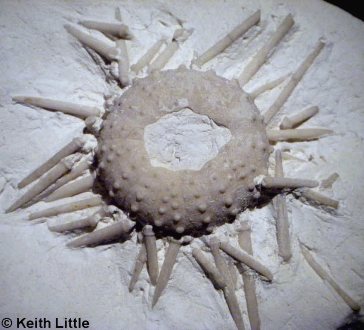 B
B |
2). Tests with associated spines; (A) Adoral view of a unique specimen, preserving a near-full compliment of ambital primary spines, articulated and in life-orientation (x2.0, White Chalk, 'Senonian' (Coniacian-Campanian), BMNH (British Museum (Natural History) London)) 38765; (B) Adapical view of a complete test with a large partially-articulated compliment of primary spines (x2.0, Seaford Chalk, Margate, Kent, in the collection of Keith Little). Image (A) © 2008 The Natural History Museum, by kind permission; Image (B) © 2009 Keith Little, by kind permission.
 A A |
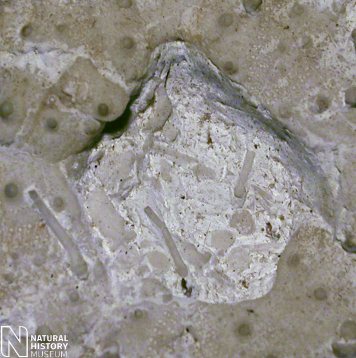 B
B |
3). Adoral view of a very well preserved specimen retaining a compliment of articulated primary spines and a large portion of the apical disc. x2.0, White Chalk, BMNH (British Museum (Natural History) London) 48766. Images © 2008 The Natural History Museum, by kind permission.
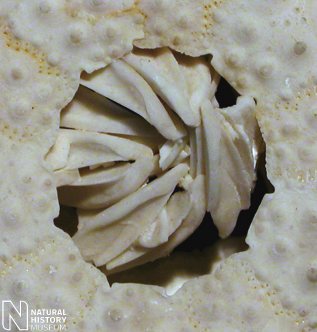 A
A |
 B
B |
4). Details of a remarkable specimen displaying an intact and articulated lantern; (A) Adoral surface of the lantern protruding through the peristome; (B) Adapical and internal surfaces of the lantern viewed though the apical opening. x6.0, White Chalk, Purley, Surrey, BMNH (British Museum (Natural History) London) E1937. Images © 2008 The Natural History Museum, by kind permission.
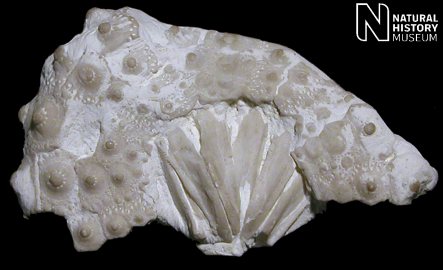 A A |
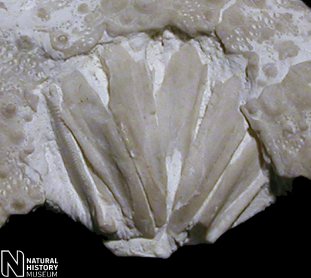 B B |
5). Adoral view of a partial test displaying the lateral surface of an articulated lantern, resting across the peristome (Seaford Chalk, Micheldever, Hampshire, BMNH (British Museum (Natural History) London) E35871); (A) Overview (x3.0); (B) Detail (x5.0) Images © 2008 The Natural History Museum, by kind permission.
 A
A |
 B
B |
6). Adoral view of a medium sized individual, with Aristotle's Lantern elements protruding from the peristome; (A) general view (x2.5), (B) detail (x5) (Middle Chalk, Lewes, Willett Collection, Booth Museum, BMB 007842, by kind permission of John Cooper).
 A
A |
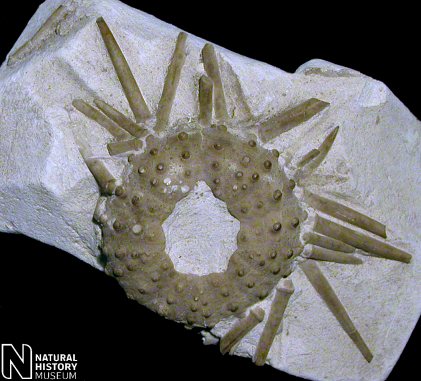 B B |
7). Adapical views of well preserved individuals retaining partial compliments of primary spines; (A) x1.4, White Chalk, Kent, BMNH (British Museum (Natural History) London) 40362; (B) x1.6, White Chalk, BMNH E1852. Images © 2008 The Natural History Museum, by kind permission.
 A
A |
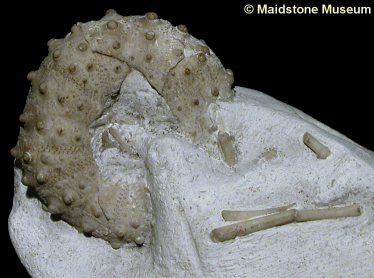 B
B |
8). Adapical views of well preserved individuals retaining partial compliments of primary spines; (A) x1.6, White Chalk, 'Senonian' (Coniacian-Campanian), Red Lion Pit, North Fleet, Kent, BMNH (British Museum (Natural History) London) E39747; (B) x3.0, White Chalk, Kent?, in the collections of Maidstone Museum, MM 20-077, by kind permission of Ed Jarzembowski). Image (A) © 2008 The Natural History Museum, by kind permission.
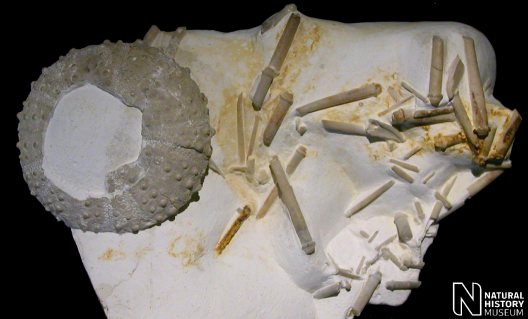
9). Adapical view of a large test with associated spines & lantern elements (x1.2, White Chalk, BMNH (British Museum (Natural History) London) 76001). Image © 2008 The Natural History Museum, by kind permission.
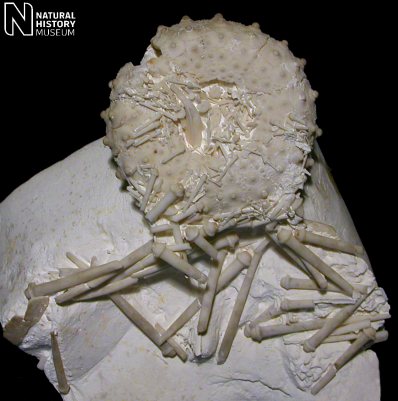 A A |
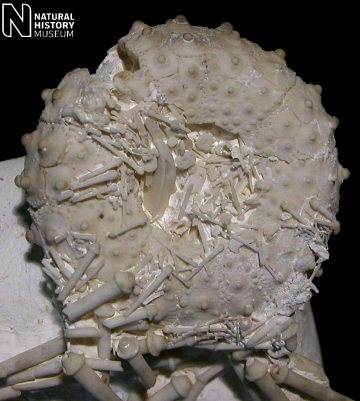 B B |
10). Adoral view of a spectacular specimen retaining a large compliment of primary spines, lantern elements and the finer skeletal elements, including a percentage of the peristomal plating (White Chalk, BMNH (British Museum (Natural History) London) E9081); (A) Overview (x1.6); (B) Detail (x2.5). Images © 2008 The Natural History Museum, by kind permission.
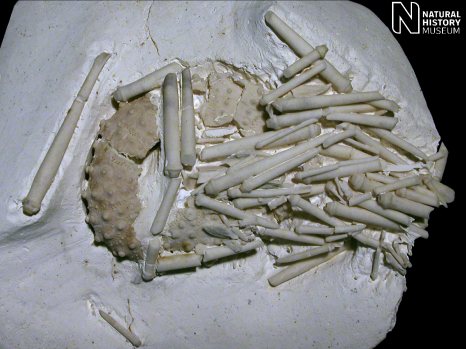
11). Adoral view of a remarkable specimen retaining a large compliment of primary spines and scattered lantern elements (x1.5, White Chalk, BMNH (British Museum (Natural History) London) E184). Image © 2008 The Natural History Museum, by kind permission.
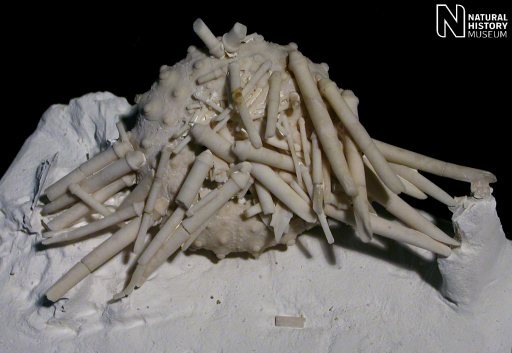
12). Adoral view of a spectacular specimen retaining a large compliment of articulated primary spines and scattered lantern elements (x2.2, White Chalk, Gravesend, Kent, BMNH (British Museum (Natural History) London) E1938). Image © 2008 The Natural History Museum, by kind permission.
 A A |
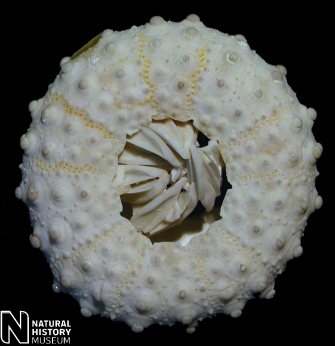 B B |
13). Adoral views of large tests; (A) Test with associated primary spines (x1.4, Seaford Chalk, Micheldever, Hampshire, BMNH (British Museum (Natural History) London) E35871); (B) Test with articulated lantern protruding from the peristome (x2.8,White Chalk, Purley, Surrey, BMNH E1937. Images © 2008 The Natural History Museum, by kind permission.
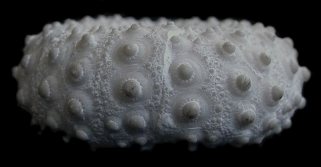 A A |
 B B |
14). Lateral (side) views of two complete tests. (A) Large, mature test, displaying the typical oblong profile (x2, Hope Gap (L. R. Strevens collection), Coniacian). (B) An unusual test with a slightly domed profile (x2.5, Seaford Head, Seaford Chalk Formation (Belle Tout Beds), Randell Collection, RR1477).
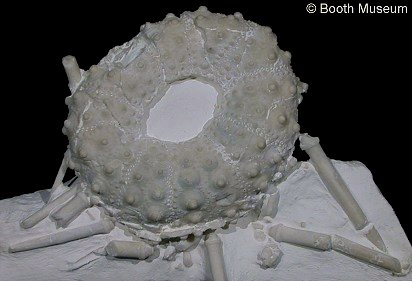 A
A |
 B
B |
15). Large tests with spines associated; (A) Adoral view, spines have a pointed / conical tip (x1.5, Seaford Chalk, Micheldever, Hampshire, ex. C. D. Day Collection, Booth Museum, BMB 024298, by kind permission of John Cooper), (B) some of these spines display a spatula-like tip (x2, White Chalk, Booth Museum, BMB 024406, by kind permission of John Cooper).
|
|
|
|
|
16). Test with associated primary spines and Aristotle's Lantern elements (Friars Bay, Peacehaven, Newhaven Chalk Formation (Uintacrinus anglicus zone, Old Nore Beds), Randell Collection, RR1456). This specimen has a curious taphonomy, and is apparently viewed from the stratigraphic underside. The lantern elements (bottom right) presumably mark where the decaying body originally rested. The test was then moved to its present position by current or scavenging activity with the associated spines trailing behind, perhaps bound by decay products or microbial matter. (A) General view (x1.3); (B) Test and associated spines (x1.6); (C) Partially articulated Aristotle's Lantern elements and associated spines. Both conical and spatula-tipped primary spines are seen (x2.0).
 A
A |
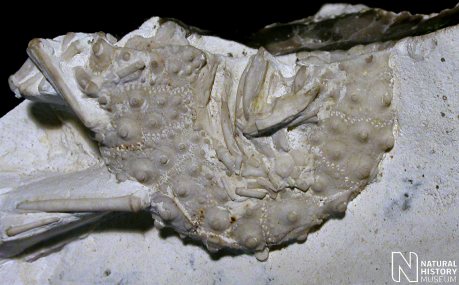 B
B |
17). (A) Adoral views of large tests with associated skeletal elements; (A) Complete test with a compliment of primary spines (x1.6, White Chalk, HCCMS (Hampshire County Council Museum's Service) collection, stored at Gosport Museum, G.1983.394, by kind permission of Dave Kemp, HCCMS); (B) Broken test encased in flint, with articulated primary spines, lantern and peristomal plates (x2.3, White Chalk, BMNH (British Museum (Natural History) London) E2198). Image (A) © 2008 The Natural History Museum, by kind permission.
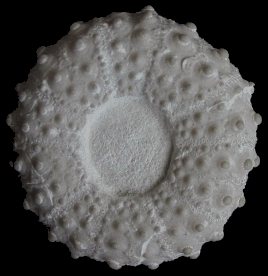 A A |
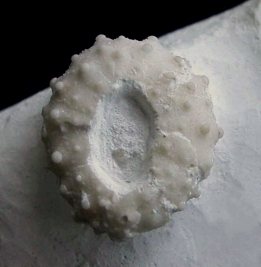 B
B |
18). (A) Adoral view of large, mature test (x2, Hope Gap (L. R. Strevens collection), Coniacian). (B) Adapical view of a small, juvenile test (x7, Beachy Head, Coniacian, Randell Collection, RR1505).
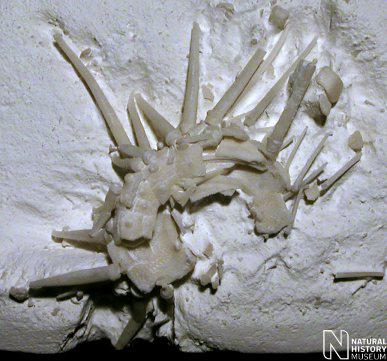 A
A |
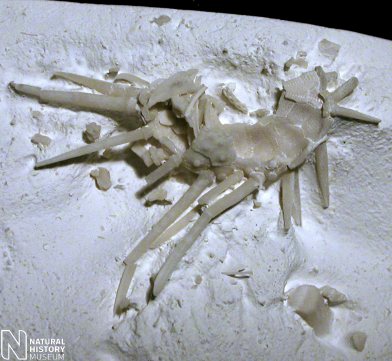 B
B |
19). Unique juvenile specimen retaining the lantern and a large compliment of articulated spines, broken through the test and prepared on two separate blocks (x5.0, White Chalk, Bromley, Kent, BMNH (British Museum (Natural History) London) 48077. Images © 2008 The Natural History Museum, by kind permission.
 A A |
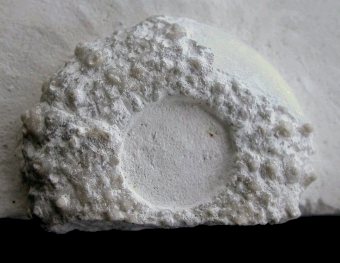 B B |
20). Adoral views of two 'obscured' tests. (A) A test encrusted by bryozoans (x3.5, Seven Sisters, Seaford Chalk Formation). (B) Incomplete test whose outer surface has been bored by the sponge Cliona cretacea (x3, Old Nore Point, near Peacehaven, Newhaven Chalk Formation). Both Randell Collection, (A) RR1805, (B) RR1445.